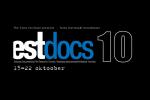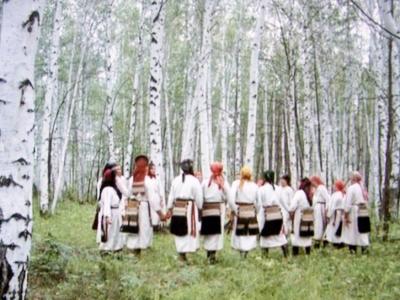Director & Screenwriter: Lennart Meri
The Winds of the Milky Way (1977 original/2009 reissue) is a relatively short film in terms of its running time of 54 minutes, but in that brief hour it travels enormous distances of space and time as it visits various Finno-Ugric peoples and observes their life-styles and some of their work-day customs and ancient rituals and listens to their myths and history and hears their folk songs.
The film uses an anthropomorphic narrative device whereby an ancient bone pendant figure of a human head is imagined as the narrator of the film who speaks to us to introduce the various Finno-Ugric peoples such as Finns, Vepsians, Votes, Setos, Mordvinians, Mansi, Hungarians, Sami, Nganasans and Estonians who are shown during the course of the film.
The narration is one aspect of the film that dates it somewhat, as more recent filmmakers have generally adopted a mantra of “show, don’t tell” as their guiding principle. While some narration is certainly necessary in order to cover this amount of material, I do have to confess I would have enjoyed an English language narrator with a dramatic style and gravitas that was more closely matched with that of actor Mikk Mikiver in the 1977 Estonian original. American-Estonian Jüri Estam delivers all of the text in a straight forward manner with clear enunciation, but some more passion would have helped bring it up closer to the level of the bar set by Mikiver.
The film’s screenwriter and director, Lennart Meri (1929-2006), had quite an extensive career as a filmmaker and ethnographer before he assumed the Office of President of the newly re-independent Republic of Estonia from 1992 to 2001. During the 1960‘s he worked as a script editor on Estonian film classics such as Viimne reliikvia (The Last Relic) (1969) and Libahunt (The Werewolf) (1968). In the 1970s and 1980s he worked on his own documentary projects which were built on ethnographic themes. His research and filming expeditions took him across the wide ranges of Siberia, east of Ural Mountains, into the lands where a few remaining small groups of Finno-Ugric peoples still make their home. As Meri said in 1999: “By the time I began to make films, I had already become quite adept at doing certain things, such as stopping trains or riding camels. If you know how to get a train to stop on an Arctic railway, then sooner or later you will become the president of a small country.”
Meri’s documentary films also include The Waterfowl People (1970), The Sounds of Kaleva (1985), The Sons of Torum (1989) and The Shaman (1997). The Shaman is an expanded short that uses the 1977 footage shot of the Nganasan shaman named Demnime who can also be seen in The Winds of the Milky Way film. The 5 films have all been remastered for reissue in a 2009 box set titled Lennart Meri: A Film Encyclopaedia of the Finno-Ugric People which is available for purchase through Estonian internet sources.
Echoing a statement once made by composer Veljo Tormis, Estonia’s master of ethnographically-based choral works, Lennart Meri summed up his film career with the words: “I am not a filmmaker, I am a traveller, an observer, an eavesdropper.” In The Winds of the Milky Way we have the rare opportunity to peek over the traveller’s shoulder and watch and listen with him.
The 2009 digitally remastered edition of The Winds of the Milky Way will have its Canadian Premiere screening at the Closing Night of the 2010 EstDocs Festival on Friday October 22, 2010 at 7 pm (preceded by a 6 pm reception). The other half of the evening will be a talk by International PEN President, essayist and philosopher John Ralston Saul where he will share his thoughts on the impact of language loss on culture and the arts, the role that the arts play in stemming language loss, and why people should care about these issues. This will all take place at the beautiful Glenn Gould Studio in the CBC Building, 250 Front St. West (at the corner of Front St. W. & John Street). For more information visit www.estdocs.com; reserved seats may be purchased through www.roythomson.com.
-----------
1The original Estonian title of the film was “Linnutee tuuled”, which would otherwise be translated as “The Winds of the Birds’ Path” as The Birds’ Path is the expression used in various Uralic, Baltic and Turkic languages to describe the galaxy known as The Milky Way in various European languages.
“The Winds of the Milky Way”1 - We come from the land of the ice and snow (3)
Eestlased Kanadas | 12 Oct 2010 | EWR
Viimased kommentaarid
Kommentaarid on kirjutatud EWR lugejate poolt. Nende sisu ei pruugi ühtida EWR toimetuse seisukohtadega.
Sorry, one more time and hopefully markup on the link will work this time, if not, then please copy/paste:
http://www.cdmarket.eu/en/shop...
http://www.cdmarket.eu/en/shop...
A lot of Estonia online stores have onerous bank transfer payment requirements and require Estonian language knowledge but I have found cdmarket.eu to be reliable and you can pay with VISA and you can negotiate their site in English if you want to. Take a look at the DVD box set here: http://www.cdmarket.eu/en/shop...
Hello,
How can I purchase this DVD to View in New York.
Many thanks,
Itzhak
How can I purchase this DVD to View in New York.
Many thanks,
Itzhak
Eestlased Kanadas
TRENDING


























